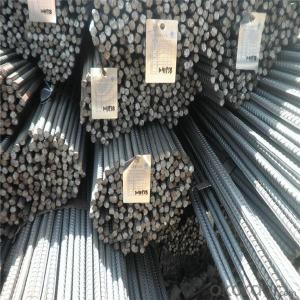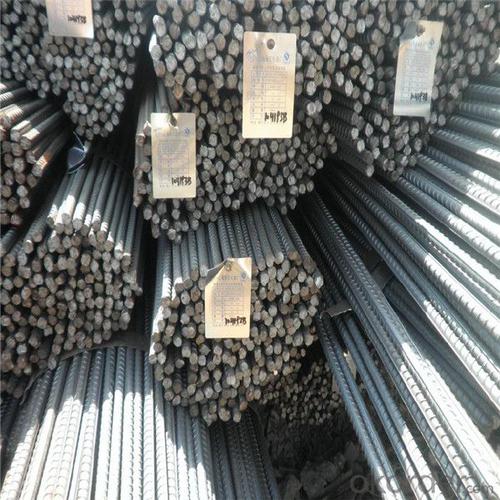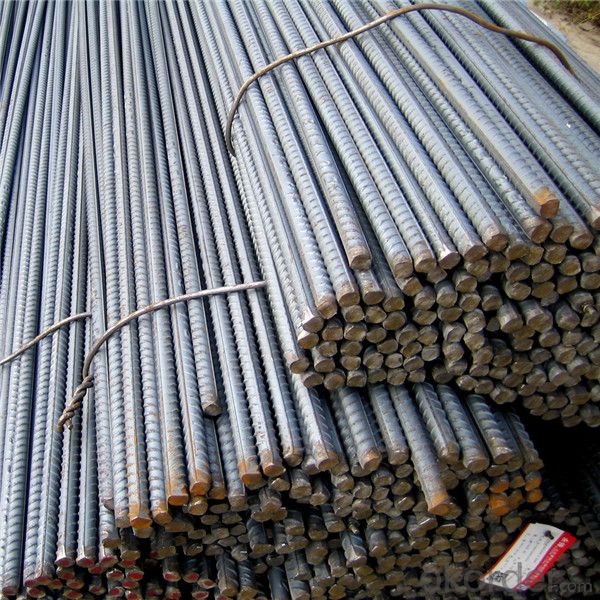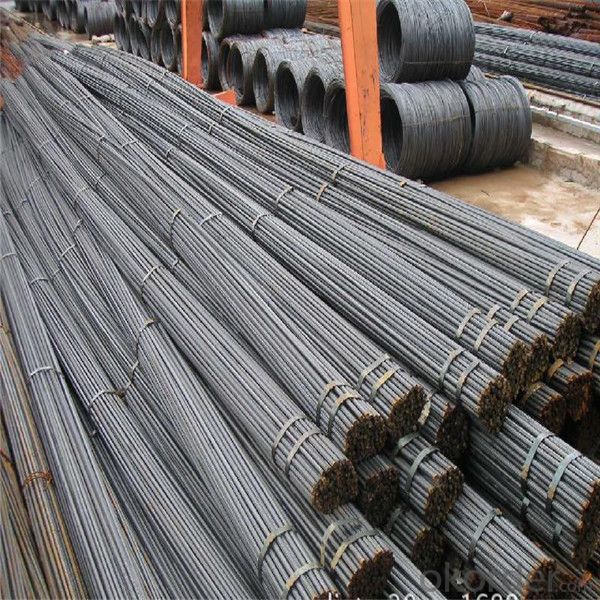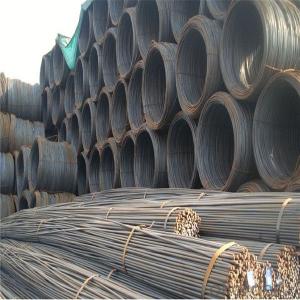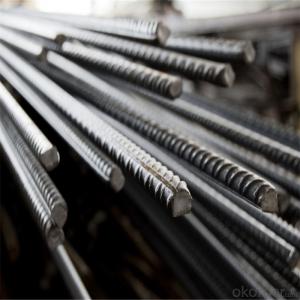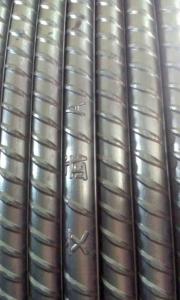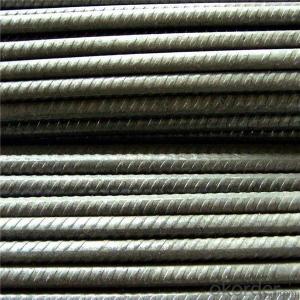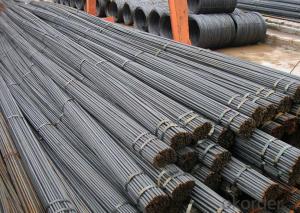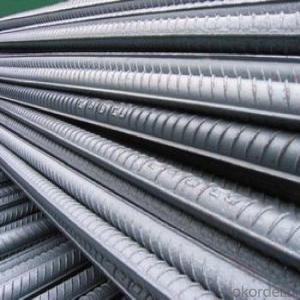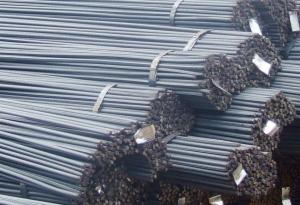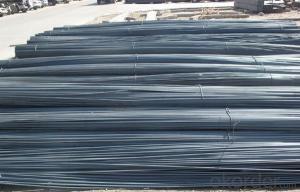Cheap Price steel rebar for Construction building bridge road
- Loading Port:
- Tianjin
- Payment Terms:
- TT OR LC
- Min Order Qty:
- 1000 m.t.
- Supply Capability:
- 17497 m.t./month
OKorder Service Pledge
OKorder Financial Service
You Might Also Like
Specification
Deformed Steel bar is a common steel reinforcing bar, used in reinforced concrete and reinforced masonry structures.
It is formed from mild steel, and is given ribs for better frictional adhesion to the concrete. The Deformed Steel bar is an iron rod , a weldable plain reinforcing steel bar, and can be used as well for steel meshes.
Product Description :
|
Features
1、Pure steel quality, stable chemical contents, small tolerance.
2、Constant Quality, good drawing performance.
3、High dimension accuracy degree, accuracy degree of Level C up to 80%, smooth surface, less scale, easy to be pickled.
4、Automatic bundling with 4 lines by Machine in tidy and good looks
5、Big high quality percentage, small coil percentage, and heavy coil weight for Hard Coil.
6、High sorbitizing percentage.
Packing:
In bundles, each bundle weight 3.5 tons. Load by container or by bulk verssel.
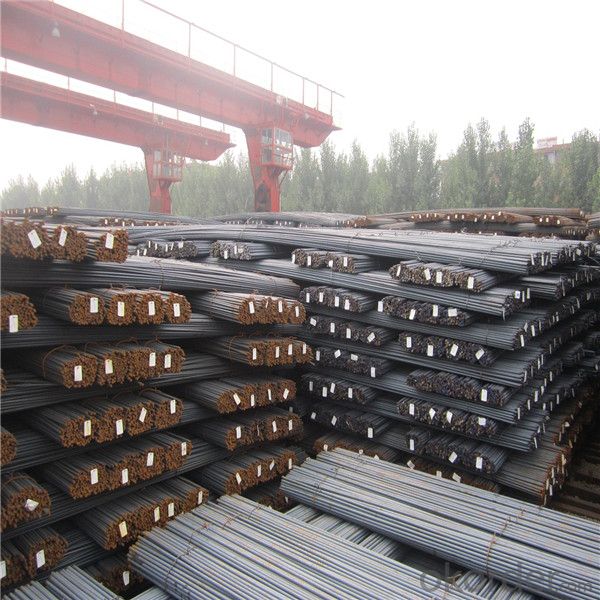

FAQ:
1.Q: What's your MOQ(minimum order quantity)?
A: One full container, mixed acceptable .
2. Q: What's your packing methods?
A: Packed in bundle or bulk ..
3. Q: How can I buy CNBM products in my country?
A:Please send us an inquiry or email ,we will reply to you if there is distributor in your country
4. Q: Can we visit your factory?
A: Warmly welcome. Once we have your schedule, we will arrange the professional sales team to follow up your case.
5. Q: How long does it take to get the product if i place an order?
A:With the process of your requirements,we will pack and deliver in 3-7 days. If it is by sea shipment,it will take 15-45 days depending on different locations
- Q: How do steel rebars contribute to the seismic performance of a structure?
- Steel rebars contribute to the seismic performance of a structure by enhancing its strength and ductility. When embedded in concrete, rebars act as reinforcement, providing tensile strength to resist the forces generated during an earthquake. This reinforcement helps prevent cracking and failure in the concrete, allowing the structure to better absorb and dissipate seismic energy. Additionally, the flexibility and high yield strength of steel rebars enable them to deform and absorb seismic forces, reducing the likelihood of structural collapse during an earthquake.
- Q: Do steel rebars need to be coated with any protective materials?
- Yes, steel rebars often require a protective coating to prevent corrosion and extend their lifespan. Coatings such as epoxy, zinc, or galvanized coatings are commonly used to protect rebars from environmental factors and ensure their structural integrity in reinforced concrete structures.
- Q: Can steel rebars be used in high-temperature applications?
- No, steel rebars are not suitable for high-temperature applications as they may lose their strength and structural integrity at elevated temperatures.
- Q: Are steel rebars susceptible to creep deformation?
- Yes, steel rebars are susceptible to creep deformation. Creep is a time-dependent deformation that occurs under sustained load, and steel rebars can experience this phenomenon over time. It is essential to consider the potential creep deformation when designing structures that incorporate steel rebars to ensure their long-term stability and performance.
- Q: Can steel rebars be used in structures with high aesthetic requirements?
- Yes, steel rebars can be used in structures with high aesthetic requirements. While rebars are primarily used for their structural strength and reinforcement purposes, they can also be incorporated into architectural designs to enhance the visual appeal of a structure. With various surface finishes and coatings available, steel rebars can be customized to meet specific aesthetic requirements, ensuring they blend seamlessly with the overall design and aesthetics of the structure.
- Q: How do steel rebars resist fatigue and cyclic loading?
- Steel rebars are specifically designed to resist fatigue and cyclic loading due to their unique properties and design. Firstly, steel rebars are made from high-strength steel, which has excellent resistance to fatigue. High-strength steel has a higher yield strength and ultimate tensile strength compared to regular steel, allowing it to withstand repetitive loading without undergoing significant deformation or failure. This property helps rebars endure cyclic loading without experiencing fatigue failure. Moreover, steel rebars are reinforced with rib patterns along their surface. These ribs increase the surface area, enhancing the bond between the rebar and surrounding concrete. This increased bond strength helps to distribute the cyclic loads more evenly, reducing the localized stress concentration. By distributing the loads, the rebars are better able to resist fatigue and cyclic loading. Additionally, rebars are often designed with a specific diameter and spacing to optimize their load-carrying capacity and resist fatigue. The design takes into consideration the anticipated cyclic loads, ensuring that the rebars are adequately spaced and sized to handle the expected stresses. The spacing between rebars also allows for proper concrete flow and consolidation during construction, further enhancing the overall performance and resistance to fatigue. Furthermore, proper installation and quality control during construction play a crucial role in ensuring the rebars' resistance to fatigue and cyclic loading. Adequate concrete cover, proper placement within the concrete, and secure anchoring of the rebars all contribute to their ability to withstand cyclic loading over time. In summary, steel rebars resist fatigue and cyclic loading through their high-strength steel composition, ribbed surface patterns, optimized spacing and diameter, and proper installation techniques. These features work collectively to enhance their load-carrying capacity, distribute loads more evenly, and minimize stress concentration, resulting in improved resistance to fatigue and cyclic loading.
- Q: What is the maximum allowable percentage of rust on steel rebars?
- The maximum allowable percentage of rust on steel rebars is typically 5%.
- Q: Are there any limitations on the maximum length of steel rebars?
- Yes, there are limitations on the maximum length of steel rebars. The maximum length is typically determined by practical considerations such as transportation and handling capabilities. Additionally, longer rebars may be more prone to bending or warping during the construction process. Therefore, there are industry standards and guidelines that set limits on the maximum length of steel rebars to ensure their effective use in construction projects.
- Q: How do steel rebars affect the overall load distribution of concrete structures?
- The load distribution of concrete structures is critically influenced by steel rebars, which play an essential role. Reinforcement is provided by steel rebars, enhancing the overall strength and durability of the concrete. Concrete is strong in compression but weak in tension, which is counterbalanced by embedding steel rebars within it. This ensures a more even distribution of the load and helps prevent cracks and structural failures by absorbing and distributing tensile forces exerted on the concrete. The presence of steel rebars effectively transfers tension forces to the surrounding concrete as the load is applied to the structure. This mechanism of load transfer results in a more balanced distribution of forces throughout the structure. The steel rebars work in harmony with the highly compression-resistant concrete, preventing excessive deflection and maintaining the structural integrity of the overall system. This is particularly crucial in large-scale concrete structures like bridges, high-rise buildings, and dams, where careful load distribution is necessary for stability. In conclusion, steel rebars have a significant impact on the load distribution of concrete structures, reinforcing the concrete and enhancing its tensile strength. They work in partnership with the concrete to ensure an even distribution and transfer of the load, preventing cracks and structural failures. The combination of steel rebars and concrete creates a robust and dependable structural system capable of withstanding applied loads and ensuring long-term safety.
- Q: Can steel rebars be used in the construction of swimming pools or water tanks?
- Steel rebars have the capability to be utilized in the construction of swimming pools or water tanks. They are often employed as reinforcement in concrete structures, thereby enhancing their strength and durability. In the process of constructing swimming pools or water tanks, it is customary to insert steel rebars within the concrete walls and floors to impart additional support and avert cracking or structural failure. These rebars are specifically designed to endure the corrosive impact of water and effectively reinforce the concrete structure against the water's force. Nevertheless, it is crucial to ensure that the steel rebars are suitably coated or safeguarded in order to prevent corrosion, as continuous exposure to water can eventually result in rust. By incorporating steel rebars into the construction of swimming pools or water tanks, the overall integrity and lifespan of the structures can be significantly augmented.
Send your message to us
Cheap Price steel rebar for Construction building bridge road
- Loading Port:
- Tianjin
- Payment Terms:
- TT OR LC
- Min Order Qty:
- 1000 m.t.
- Supply Capability:
- 17497 m.t./month
OKorder Service Pledge
OKorder Financial Service
Similar products
Hot products
Hot Searches
Related keywords
